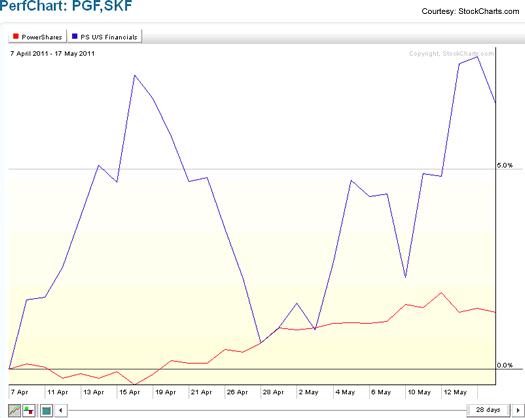Leveraged ETFs A Look At The Potential (And Peril) Of Short and Leveraged ETFs Jim Trippon
Post on: 13 Июль, 2015 No Comment

Leveraged ETFs: A Look At The Potential (And Peril) Of Short and Leveraged ETFs 0 comments
Jan 20, 2010 3:47 PM
A Look At The Potential (And Peril) Of Short and Leveraged ETFs
One of the best things about ETFs is that they give investors a relatively conservative avenue for making bearish plays when the market dictates that’s the way to go. Directly shorting stocks or other asset classes is inherently risky because there is no limit to how high a security can rise in price. In addition, the margin requirements in your brokerage account can eat away at your returns even if you’re on the right side of a short trade.
Those are just a few reasons why we like short, or inverse, ETFs as a preferred way of adding some bearish hedges to your portfolio. We should emphasize that we have a strong preference for plain vanilla inverse ETFs, not the leveraged vehicles that have been the source of enormous controversy over the past two years. For investors looking for a bearish alternative to equity ETFs or ETFs that track indexes such as the Dow and Nasdaq, there is likely a straight bearish alternative. These unleveraged ETFs usually provide a fairly close inverse correlation to their bullish peers.
For example, if the S&P 500 falls 2% on a given day, the equivalent straight bearish ETF should be up by approximately 2%. Sounds pretty simple, right? Well, there are some things you need to be aware with inverse ETFs, particularly the leveraged ones. To accomplish their bearish objectives, leveraged and inverse ETFs use swaps, options and futures contracts, among other assets that many retail investors may not be comfortable.
Beyond that, leveraged ETFs, the products that are designed to offer two or three times the bullish or bearish performance of a particular index, sector or other asset class, rebalance themselves on a daily basis. What this means is that you could hold a double or triple inverse ETF that tracks the Nasdaq for a couple of days while the index plummets and make a tidy profit. Hold the same ETF for an extended period of time, say two months, and even while the Nasdaq moves down over that time, you could end up LOSING money.
What we’re saying is that while leveraged ETFs are appealing products for short-term traders, the aspect of daily rebalancing puts investors at risk for substantial losses even if the underlying index does what you think it will do. The bottom line is do NOT consider leveraged ETFs as long-term holding. Keep your holding period to a couple of days at the maximum.

Plain vanilla inverse ETFs are a safer alternative to their leveraged peers, but even with these products, we view a lengthy holding period as something that may put investors at risk, especially during volatile markets. Overall, we view inverse ETFs as something investors should consider as short to medium-term portfolio hedges. Just be sure to do your homework before purchasing one of these products.
For more information about The ETF Profit Report, visit etfprofitreport.com /. To see the latest special offer from The ETF Profit Report, visit: www.etfprofitreport.com/sign-up-etf-prof.
Disclosure: no positions
Instablogs are blogs which are instantly set up and networked within the Seeking Alpha community. Instablog posts are not selected, edited or screened by Seeking Alpha editors, in contrast to contributors’ articles.














